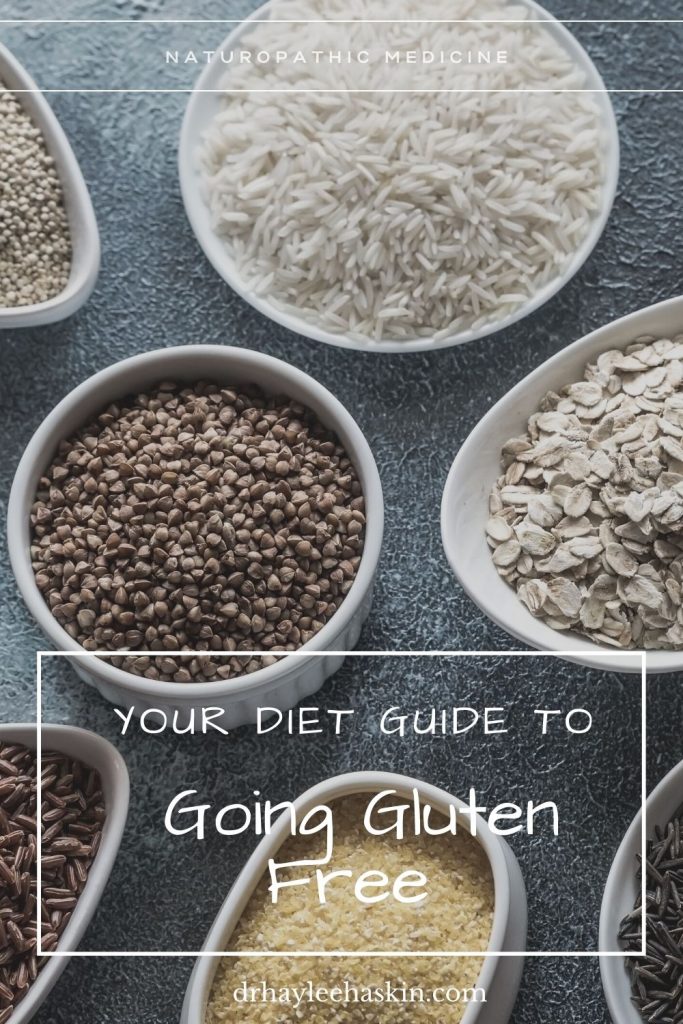Your diet guide to going gluten free will help you determine what foods contain gluten, how to shop, and how to prepare gluten free foods.

What is Gluten?
Gluten is a protein that is present in numerous grains. Along with a protein called gliadin, the proteins provide a chewiness to breads, along with helping it rise. Gluten is most likely to be found in products such as bread, pasta, baked goods, soups, cereals, and sauces. Wheat is the most commonly consumed gluten containing grain, but it can also be found in numerous other grains and additives.
Why is Gluten bad for me?
There are two types of gluten reactions. The first is celiac disease. Celiac disease is a condition where the ingestion of gluten causes an immune reaction in the body. This immune reaction causes your own body to attack your intestinal walls. This can lead to intestinal damage, and consequently can impair digestion. This significantly reduces the ability to absorb nutrients. Symptoms include abdominal pain, diarrhea, fatigue, headaches, infertility, and weight loss. Surprisingly, celiac can also be completely asymptomatic.
Gluten sensitivity is another reaction people can have from gluten. For people with gluten sensitivities, they have a hard time recognizing and digesting gluten. This is especially true for the North American grains. In turn, gluten will cause significant inflammation in the digestive system and can cause symptoms such as pain, bloating, diarrhea, constipation, eczema, and acne.
Testing these two conditions are much different, so it is important to talk with your doctor for comprehensive testing if you have any of the symptoms above. Treating these two conditions, are much in the same. Simply eliminate gluten from the diet.
Grains & Gluten
The first step to going gluten free is knowing what grains contain gluten. Below is a list of the most common grains eaten, and whether or not they contain gluten.
Contains Gluten
- Barley: contains gluten
- Wheat: contains gluten
- Rye: contains gluten
- Kamut: contains gluten
- Spelt: contains gluten
Gluten Free
- Buckwheat: gluten free
- Corn: gluten free
- Quinoa: gluten free
- Rice: gluten free
- Millet: gluten free
- Amaranth: gluten free
- Oats: gluten free, but often are cross contaminated with gluten products. Buy gluten free.
Hidden Sources of Gluten
Eating gluten free isn’t easy for a majority of people because we don’t always know the ingredients in the food we are eating. Identifying what food additives could contain gluten is an important step in going gluten free. Below or some hidden sources of gluten to be on the look out for when eating gluten free.
- Hydrolyzed Plant Protein or Hydrolyzed Vegetable Protein (HPP or HVP) can be a source of wheat or corn.
- Modified Food Starch is often modified wheat starch.
- Natural and/or Artificial Flavorings can sometimes be hydrolyzed protein. Sometimes for flavoring, they use barley, malt or rye.
- Starches aren’t always specified by type, and can be from wheat or barley.
- Dextrin is used as thickener in recipes. This can be made of corn, rice, tapioca, wheat or potato. If wheat is used, it should be identified as wheat dextrin, but that isn’t always the case.
- Individual spices won’t contain gluten, but a mixture might carry wheat starch as a binding agent. It should be noted on the label.
- Also watch for things such as vodka and any liquor made from gluten containing grains, thick soups (such as chowder or bisque thickened with flour), gravy, and malt vinegar.
Kitchen Tips
Eating gluten free at home can be extremely hard if you have other family members or friends who eat gluten. Following these kitchen tips is an important step in going gluten free to prevent cross contamination and additional exposure to gluten containing ingredients.
- Prepare gluten-free foods first.
- Store your gluten-free foods in a separate place in the kitchen.
- Use separate or thoroughly washed utensils when cooking.
- Thoroughly clean kitchen items that touch gluten products, such as toasters, before using them with gluten-free products.
Shopping Suggestions
Learning how to shop gluten free can be frustrating for people. Below are some additional suggestions on how to shop gluten free.
- Read labels. Manufacturers and store clerks are often misinformed about what is and what is not gluten-free.
- Avoid bulk stores where cross contamination in the air and with scoops is common.
- Note that deli meats, spice combinations and any products such as pre-made burger and crab cakes often contain gluten and wheat as a binding agent.
- Check your beauty and hair products, as this is often a cause of unknown gluten exposure.
Resources
Below are some additional resources that can help you on your journey to becoming gluten free.
LEARN MORE:
PIN FOR LATER


